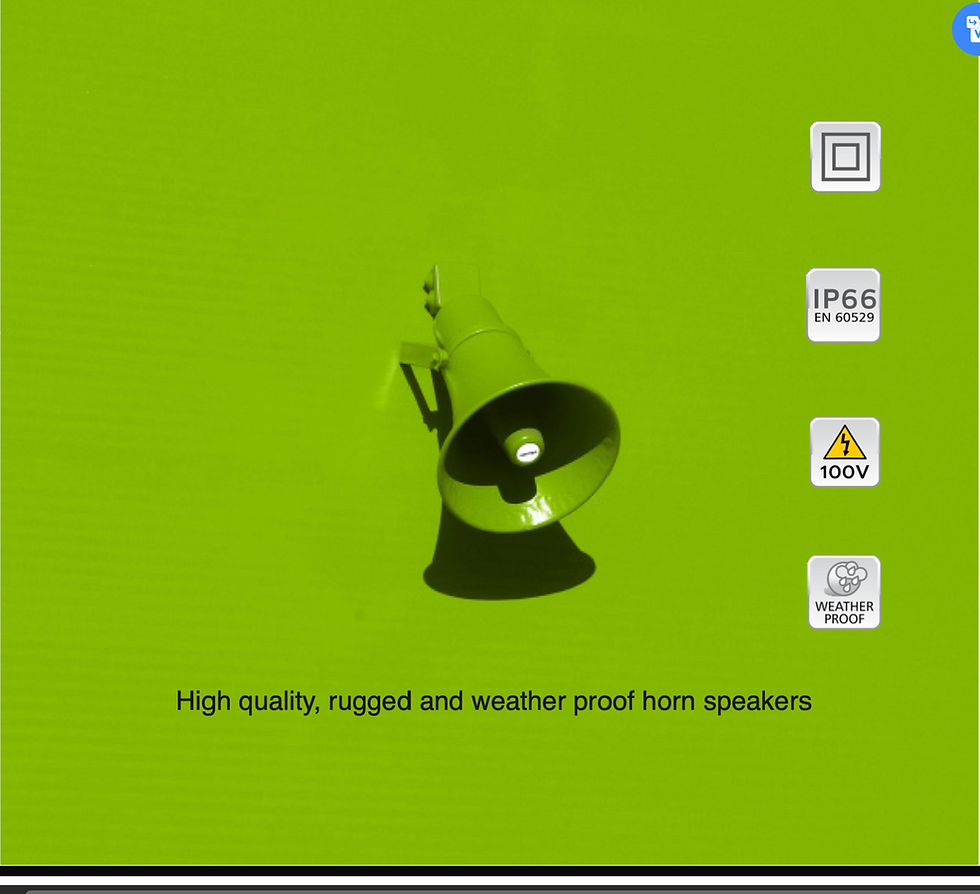How to Save Your Wall Speaker in the Public Address System
- Esmaeel Alshikh
- Oct 13, 2024
- 4 min read
In this article, we will provide detailed answers to the following questions and address many of your inquiries:
What are the common causes of damage or failure in wall speakers?
What are the main components of a wall speaker?
How often should wall speakers be cleaned?
What environmental factors can negatively impact wall speaker performance?
How can you troubleshoot a wall speaker that is not producing sound?
When should you seek professional help for wall speaker maintenance or repair?
What proactive steps can be taken to prevent wall speaker failures?
Article Contents

Introduction
In public address systems (PA systems), wall speakers are crucial in delivering clear and intelligible sound to audiences in various settings, such as schools, hospitals, and commercial establishments. However, these speakers can be susceptible to damage or failure due to various factors, including environmental conditions, misuse, and aging. To ensure your wall speakers' longevity and optimal performance, it is essential to implement proper maintenance and troubleshooting techniques. This article will delve into effective strategies to safeguard your wall speakers and maintain their functionality in a PA system.

Understanding Wall Speaker Construction and Function
Before exploring maintenance and troubleshooting techniques, it is imperative to understand the basic construction and function of wall speakers. These speakers typically consist of a loudspeaker driver, a crossover network, and a mounting enclosure. The driver is responsible for converting electrical signals into sound waves, while the crossover network filters the signal to ensure that appropriate frequencies are delivered to the driver. The mounting enclosure provides protection and enhances the speaker's acoustic performance.

Regular Cleaning and Maintenance
One of the most fundamental aspects of wall speaker maintenance is regular cleaning. Dust, dirt, and other contaminants can accumulate on the speaker grille and driver, hindering sound quality and potentially causing damage. To clean your wall speakers, follow these steps:
Disconnect the speaker from the power source. This is crucial to prevent electrical shock and ensure safety.
Remove the speaker grille. If possible, detach the grille carefully to access the driver and other components.
Use a soft, dry cloth to wipe away dust and dirt gently. Avoid using harsh chemicals or abrasive materials that could scratch or damage the speaker's surface.
Inspect the speaker for any signs of damage. Check the driver, crossover network, and enclosure for cracks, tears, or other abnormalities.
Reattach the grille and reconnect the speaker to the power source.
In addition to cleaning, regular inspections are essential to identify potential issues early on. Check for loose connections, frayed wires, or signs of water damage. Addressing these problems promptly can prevent more significant issues and prolong the speaker's lifespan.

Environmental Considerations
Environmental factors can significantly impact the performance and longevity of wall speakers. Excessive humidity, extreme temperatures, and exposure to corrosive substances can all contribute to degradation. To protect your speakers from environmental hazards, consider the following:
Install speakers in well-ventilated areas. This helps to reduce moisture buildup and prevent mold or mildew growth.
Avoid exposing speakers to direct sunlight or heat sources. Excessive heat can cause the speaker's components to deteriorate.
Use protective covers or enclosures when necessary. If your speakers are located in outdoor areas or exposed to harsh weather conditions, consider using protective covers or enclosures to shield them from the elements.

Troubleshooting Common Wall Speaker Issues
Despite proper maintenance, wall speakers can still experience problems. Here are some common issues and troubleshooting tips:
No sound:
Check the speaker's power connection and ensure it is securely plugged in.
Verify that the speaker is connected to the PA system correctly.
Inspect the speaker's wiring for any breaks or loose connections.
Test the speaker with a different audio source to isolate the issue.
Distorted sound:
Check for excessive volume levels, which can lead to distortion.
Inspect the speaker's driver for any damage or debris.
Verify that the crossover network is functioning properly.
Consider replacing the speaker if the distortion is severe or persistent.
Buzzing or hissing sounds:
Use shielded cables and proper grounding techniques to check for ground loops or interference.
Inspect the speaker's components for any loose or faulty parts.
If the issue persists, consult a professional technician for further troubleshooting.
Professional Maintenance and Repair
While most routine maintenance tasks can be performed by facility staff or technicians, some issues may require the expertise of a professional audio engineer or repair technician. If you encounter complex problems, such as driver failure, crossover network issues, or extensive damage, it is advisable to seek professional assistance. A qualified technician can diagnose the problem accurately and implement appropriate repairs or replacements.

Preventive Maintenance and Future Planning
To minimize the risk of wall speaker failures and ensure optimal performance, it is essential to implement a proactive preventive maintenance plan. This plan should include regular cleaning, inspections, environmental monitoring, and professional maintenance as needed. Additionally, consider the following strategies:
Invest in high-quality speakers. Choosing reliable and well-constructed speakers can help to improve longevity and reduce the likelihood of failures.
Consider redundancy. If your PA system relies heavily on wall speakers, consider implementing redundancy by installing backup speakers or a distributed audio system.
Stay updated on industry best practices. Keep informed about the latest maintenance techniques, troubleshooting strategies, and technological advancements in the field of public address systems.

Conclusion
By following the guidelines outlined in this article, you can significantly enhance the lifespan and performance of your wall speakers in a PA system. Regular maintenance, proper environmental care, and timely troubleshooting are essential components of a successful wall speaker maintenance program. By investing in the care and preservation of your wall speakers, you can ensure that your PA system delivers clear, reliable, and high-quality sound to your audience.




Comments